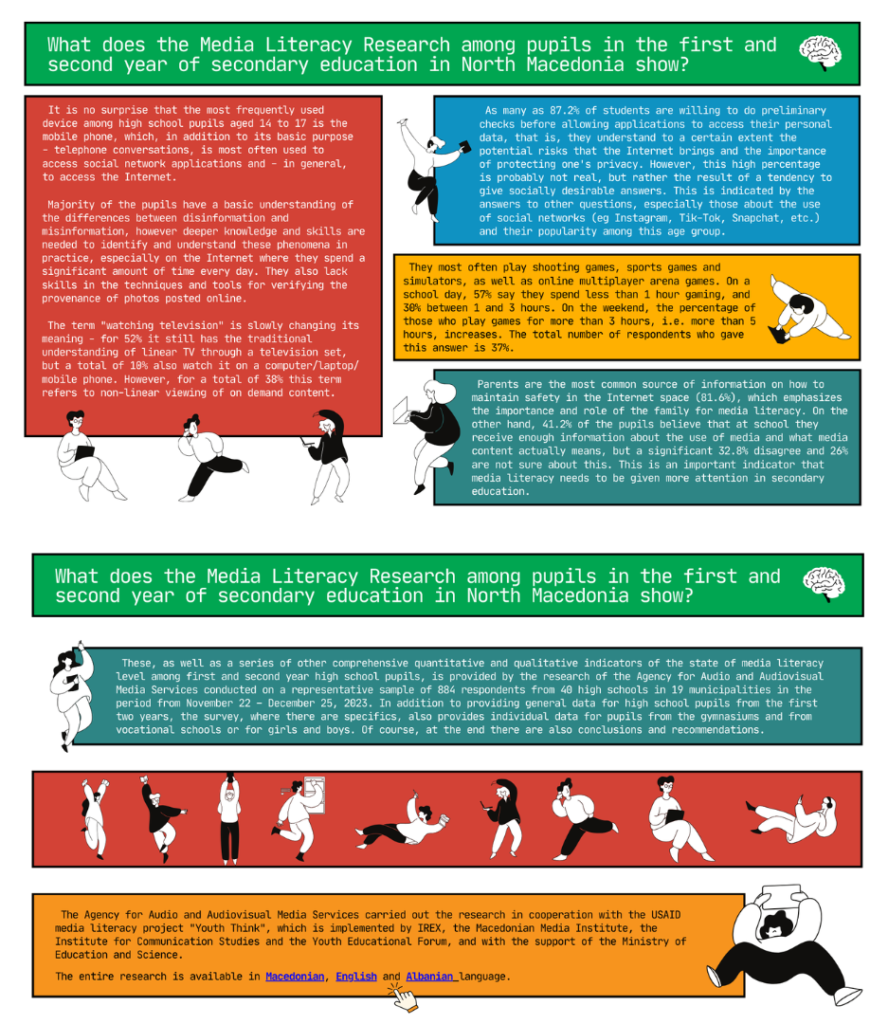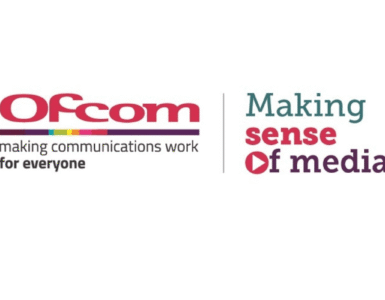by Emilija Petreska-Kamenjarova, Agency for Audio and Audiovisual Media Services, Republic of North Macedonia.
I believe that nowadays it is a common place knowledge that the reality of the younger generation is completely different from what it meant for us – generations who witnessed the rise of the Internet into an ever-present necessity of day-to-day life. For my generation, buying the first PC and setting up the first e-mail address were life changing experiences. While young people were born with the desktop being just another home appliance, the laptop was their elders everyday tool and the mobile phone – an extension of their parent’s hand.
It was against this backdrop that we at the Macedonian media regulatory body – Agency for Audio and Audiovisual Media Services, took upon ourselves the task to obtain a more in-depth understanding of the media literacy level of students in the first and second year of secondary school (ages 14 to 17).
This kind of a nation-wide study needed to be conducted in cooperation since its aim was to provide representative data for the ongoing reform through which media literacy is being introduced in secondary education. It was therefore carried out in cooperation with the USAID media literacy project “YouThink”, which supports this reform, and is implemented by IREX, Macedonian Institute for the Media, Institute of Communication Studies and Youth Educational Forum. The Ministry of Education and Science provided gender segregated data on the total number of students in both gymnasiums and vocational secondary schools in the country, and allowed for the interviews to be carried out in the schools.
We learned how these young people use traditional and social media, Internet and mobile phone, their gaming habits, content and information recognition, their knowledge on safety in online sphere and their critical thinking skills. Results were published in the “Research on Media Literacy Among First and Second Year Students in Secondary Education” available in Macedonian, English and Albanian. It would be impossible to give an overview of all the findings and do them justice so this text highlights just some of the data regarding critical thinking.

More than half (53.2%) of the students recognized the headline “SHOCKING: Look what was happening yesterday in Skopje… be prepared!” (VIDEO)” as clickbait; slightly over one-fifth considered it as objective informing, while 17,2% didn’t know what it was. The headline “Fans protested in Skopje before the football match: Let’s kill the “dogs”!” was recognized as hate speech by 58.3% of the students. However, a point of concern and planning for future activities is the finding that a total of 41.7% did not recognize it (some thought it was sports reporting, some fake news and some were not sure). When deciphering facts from opinions, they most often recognized historical and scientific facts (World War II ended in 1945 – 55.2%; Earth is the third planet from the Sun – 47.9%). However, 35.6% of the students thought that the opinion “Dog is the man’s best friend” was a fact.
More than half of the students (57.2%) knew that their feed showed them posts of people they liked and commented on, about a third thought it resulted from the more extensive activity of others on social media, while 10.1% assumed others were not their friends anymore/stopped following them. If their friend sent them link stating: “Wow, I could never imagine you could do this. There are even photos.” 68.2% would check with their friend before clicking, 10.4% would put a sticker over the camera on the laptop/phone, and 13.6% would think it was a joke and click out of curiosity.
Another concern was raised by the fact that almost all students (96.3%) were not familiar with techniques/tools for verifying the origin of a photo on Internet. Just 3.7% knew of such tools, most often naming Google Lense or Google Images.
If they suddenly noticed a lot of photos of older people in their social media feeds and realized their friends used FaceApp, the largest majority (87.2%) would first check what data the application would access and think whether to install it. Only a total of 12.8% would consider there was no danger (some would allow access without concern, some even without thinking). A high level of awareness, one would think. But a cross-reference of these data with other results showed discrepancy. For example, almost half of the students (47.9%) stated that they read the Terms of Use before registering on social media or applications, but a total of 52.1% didn’t do that (37.3% didn’t have time for it, and 14.8% wouldn’t waste their time, because they couldn’t change the Terms).
This points to the “socially desirable responding” – students know what they should do, but in practice they act differently. And this is not unusual since, as Ana Frichand (Doctor of Psychology tasked with interpreting the study’s data) pointed out – ”it is not atypical for adolescents to fall under peer pressure and show inconsistent behaviour… [since] the brain development is more attuned to social support than to long-term behavioural consequences… [so] the period of middle adolescence has a great potential for the development of critical thinking through appropriately chosen activities“.
Author
Emilija Petreska-Kamenjarova, Assistant Head of Programme Affairs Department, Agency for Audio and Audiovisual Media Services, Republic of North Macedonia.














